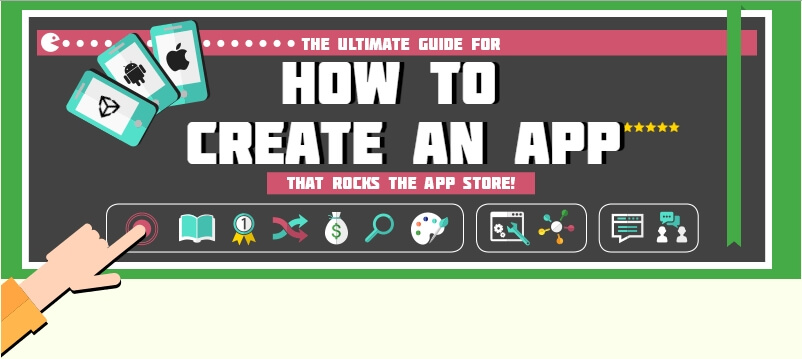

How to
Create an App


How to
Create an App
App Store Optimisation (ASO) is the process of ensuring that people are able to find your app on the app
distribution platform you’ve chosen. By using ASO techniques to make your app more visible – i.e.
increasing your app store ranking – you will get more traffic and more downloads.
Traffic from app stores is the most viable traffic source for app developers. In fact, as appfreak
owner, Martin Palsovic, highlights in his great post about ASO, 63 percent of all new mobile app installs originate
from search results (according to Forrester research firm).
When it comes to ASO, there are some factors (including
your app name, app keywords, and description) that you are able to modify in
order to boost your ranking. Moreover, most app store algorithms also take into account reviews and ratings
that (as we have seen in the previous chapter) you may have some influence over, but are essentially out of
your hands.
In terms of how ratings and downloads impact on your ASO, Apptentive demonstrates in their free ASO
ebook that there is a clear correlation between higher ratings equating to higher search result
rankings, and likewise for higher download volumes having similar positive results.

Although it is worth noting that the latter are not 100% mutually exclusive – timeliness also plays a role as new apps with lower downloads can outrank old apps that initially had higher download volumes. However, as this kissmetrics App Store Optimization article highlights, higher volumes of downloads generally mean a higher ranking.
This chapter primarily focuses on optimising the most important variables that you have control over so that you are able to ensure that your app is as visible as possible, and receives the downloads it deserves. Again, the previous chapter touches on one way to optimise those variables that are seemingly out of your control.
Including keywords in your description can make your app more likely to appear when people make related searches. However, putting in too many keywords (to the point where the copy becomes difficult to read and has an inhuman feel) will likely have the reverse affect. In fact, heavily loading your copy with keywords now
has a
detrimental effect in terms of your search engine results page (SERPs) rankings. This means you
need to strike a balance. In general, some keywords will fit into your description quite naturally. And,
if you find yourself overusing one, you may be able to exchange it directly for another one. Play around
until you get something that reads clearly and naturally, while also contain a healthy amount of
keywords.
You need to consider all the variables, and learn from those who have been down this journey before you.
Indeed, if you are stuck on how to achieve a good balance with your keywords or need some inspiration,
there are some great opinions and pieces of advice provided by ASO experts on various questions within
Quora, such as these for example.
Flipboard nail their balance of keywords and human copy, using the keywords “personal magazine”, “news”, “follow topics”, “videos” and “photos” in just their intro! The copy reads very well and certainly doesn’t seem to be jammed or overstuffed with keywords.
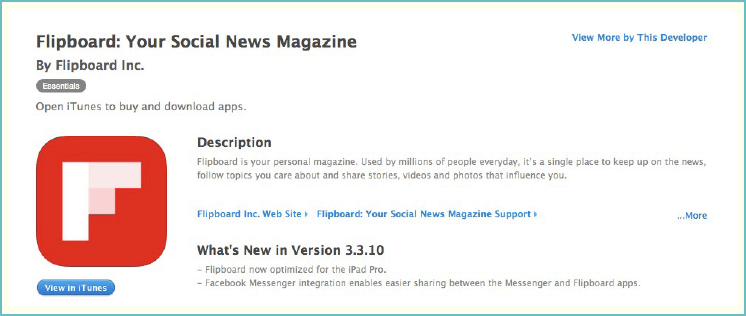
VR Toilet Simulator, on the other hand, use a description that contains very few keywords, and uses odd, disjointed copy.
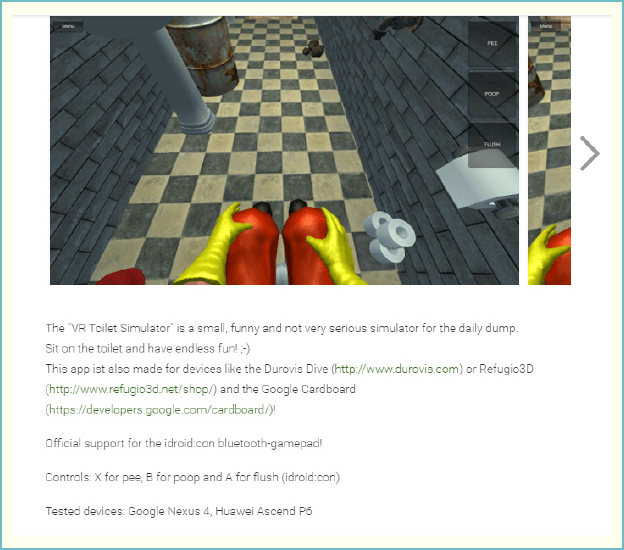
To figure out which keyword you’re going to use, it’s a good idea to start with a blank piece of paper
and simply write down all the keywords that are relevant to your app. If you’ve followed the research
process outlined earlier in this guide, then you may already have a good idea about what your keywords
are. Then think of common misspellings (as people will type these in by mistake, so you can take
advantage of this!) and synonyms of each word to extend your list even more.
Moreover, it is worth making more specific searches – like a competitor’s name – since traffic for these
may be quite low, which could therefore highlight an opportunity to rank higher more easily than if
there are lots of results served up by the search.
With your original ideas on paper, the next step is to look at what keywords your competitors are using.
By searching the most relevant keyword for your app, you will be able to see your most direct
competition and the keywords they use. See which ones they’re using on their app’s listing, and add them
to your list.
Your list may be quite long now, but don’t worry. By cutting it down using keyword research, you will
end up with a list of the most important keywords for your app. There are various paid tools that help
you to generate keywords for your app and show you how often they are searched for – the more
competitive (the more commonly used) they are, the harder it will be to be found.
These keyword tracking tools include:
For a completely free tool, you can always use Google AdWords’ Keyword planner, which is a fantastic
help although doesn’t have the depth or sophistication of some of the paid tools.
Szilard Szasz-Toth, Co-Founder of Mad Labs Dev Blog provides extensive information about the keyword
research process in this great post, as well as some highly helpful advice on how
to use the Google keyword planner for the ASO process of your app.
Ideally, you want keywords for which traffic is high and competition is low. Using as many of these
keywords as possible in your app’s listing will mean that you have the best chance of showing up in a
large number of searches.
The first place you should list your keywords is in the Keyword Field. Here you have 100 characters to
couple your app with your best keywords. Use commas to separate each keyword, and make sure that you
reach the character limit to take full advantage.
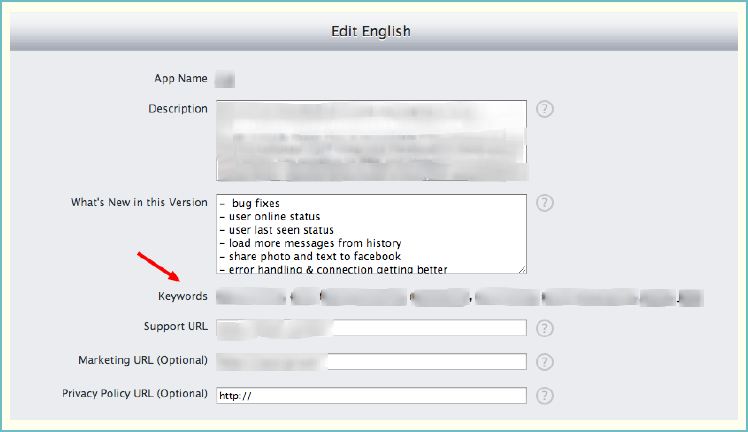
You app’s name must be short, catchy and descriptive…after all, this is what will always be mentioned whenever people talk about your app, whether in a positive or negative light. It is also one of the best ways to boost the ASO ranking by including keywords. (Please refer back to the “Keywords” section of this
chapter for some excellent free and paid-for tools that you can use.)
Including a keyword (or keywords) in the app name can help your app rank higher by, on average, 10
percent than those that don’t include a keyword. However, using a keyword in your name is fast-becoming
mandatory – in just the space of a few months, according to this
blog post by TUNE, those apps including keywords in their title has jumped from 16 percent to 51
percent! Some well-known examples include Spotify Music, Gmail – email from Google, and Vine – video
entertainment.
If you’re concerned that shoehorning a keyword into your title may have a negative impact on your name
(by making it too long or clunky) or may damage your brand, by separating the keyword from your name
with a hyphen or colon, you can effectively keep your name intact, using the keyword simply to add more
description.
By separating the app’s true name (“FotoRus”) from the keyword (“Photo Editor Pro”), the developers of
FotoRus manage to ensure the integrity of the app’s name whilst supplementing it with additional
description in the form of a keyword.
Furthermore, localising the name of your app is a smart move for ASO, particularly if it is
geography-specific or has geo-specific functionality within it. The only significant caveat here,
however, is whether your app name has a trademark, proper name, or universal brand name within it…in
which case, it is best to leave it well alone.
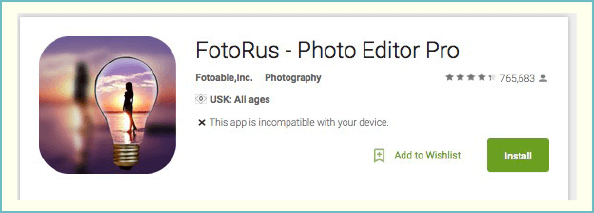
We covered the key aspects of app localisation within the previous chapter on marketing, so refer back for a refresher on the value of taking this approach. Specifically on the app name, however, localising / translating it will really help it to appear in searches when those in different countries are searching for keywords in their particular language.
A great example of when it is worth doing is with navigation apps, such as maps, route finders and such like. Even if your app caters for multiple countries and languages, users in different countries would search on the app store for “map apps” or “route finder” in their native language. Sygic is a great example of how they have embraced this approach to capture as many diverse countries and languages as possible:
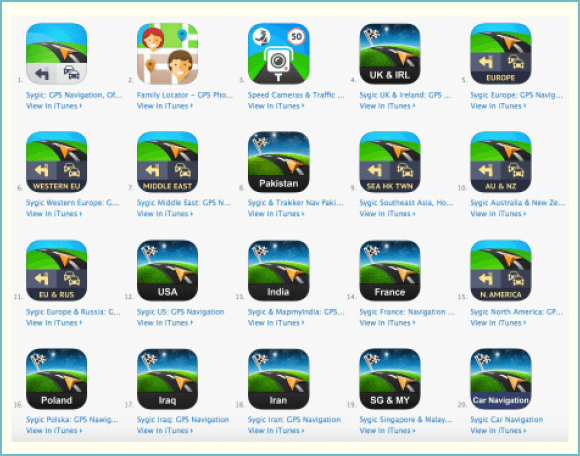
You have 580 characters to get your audience hooked – that’s as many characters will show before
clicking “more” in the app store. When it comes down to it, that’s not a lot. This means that your intro
needs to be spot on.
A good intro will include
your value proposition.
This is one sentence that sums up what makes your app so great – it is key in hooking the reader into
your app.
It’s also valuable to include media mentions, such as “featured on Tech Crunch” (if you
have any) as well as
any quotes from influencers, for example: ‘“This app changed my life” – Barry
Influencer’. If you have created a previously successful app, something along the lines of “from the
creators of…” is a good way to link previous success with your latest offering.
With all of this in mind, creating a killer intro requires creativity and skill. Don’t be afraid to push
the boat out. Just make sure you convey all of the information you want to in an interesting way. Again,
check out your competitors for how they are positioning themselves and “selling” their app. Learn from
this and adapt accordingly.
Threes get their intro bang on, by:

Duolingo keeps it short and simple, and make a big point of highlighting that the app is Apple’s iPhone App of the Year!

Pedometer++ opts for a slightly longer intro, listing key benefits and tech info.

Full app descriptions are usually around 300-500 words. But, though this may sound like a lot, it takes
less than a minute for people to read. It’s important, then, that every word is pulling its weight.
This text should be clear, concise,
relevant, and user-centric.
This last point is especially important. People don’t want to hear about how great you are; they want to
know how your app will make their lives better.
This means translating features into benefits. For example, if you’ve created an app that turns users’
phones into a torch, then, instead of saying “make your phone into a torch” (a feature) you can say
“never be caught out without a torch again” (a benefit).
Finally, your description should end with a call to action – an invitation to download your app. If your description has worked, then you want to remind people that they can download your app when they’re all fired up about it.
Virtuose Piano Free 3 uses short, punchy paragraphs to list key benefits (“Learn to play the piano anytime and anywhere”), quotes from reviews to give authority (“’Another free gem’ – Engadget”), and a full features list (“88 keys of sampled pianos, 7 instruments, robust bass, etc.”) to encourage downloads.
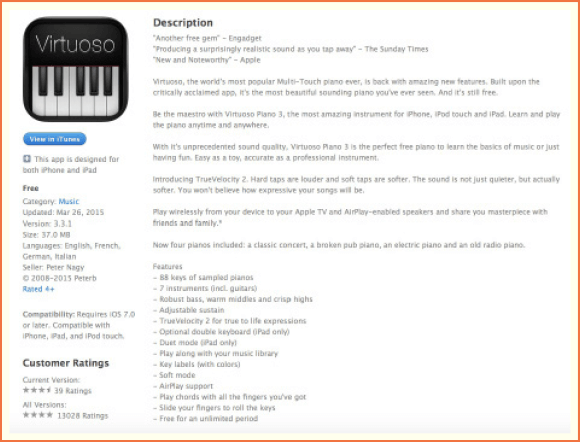
Calm uses a snappy question intro (“Need a little more calm in your life?”), brief overview (“Calm can help you meditate, sleep, relax, focus and much more”) , a highlights reel (“learn the basics of mindfulness in our free introductory program, 7 guided meditation sessions for 2 to 30 minutes, 10 beautiful immersive nature scenes” etc.), and customer reviews (“This app has changed my life”) to give potential users a comprehensive and positive idea of what the app offers.
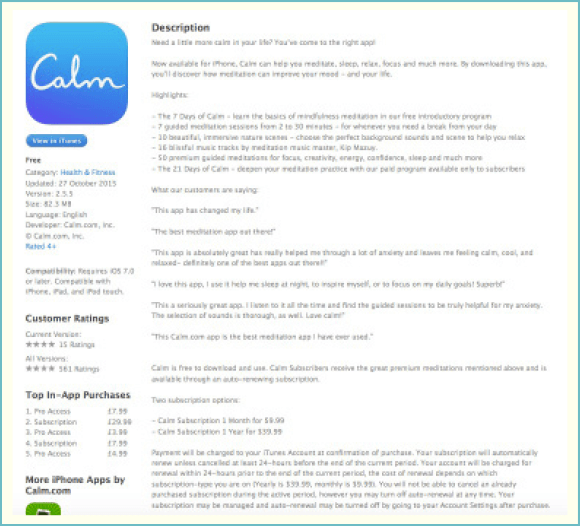
All of the major app distribution platforms will rank apps with more installs higher than those with
less installs. This remains true whether those installs are paid or not. We touched on this a little in
the last chapter, but it’s an important aspect of ASO too so be sure to revisit this section in the
previous chapter for a refresher. In short, the more downloads you have, the better. And buying installs
often leads to an increase in organic installs.
Once the number of installs you have reaches a critical mass, you will see a massive increase in organic
installs. This is because your app will be more visible, and therefore attract more organic installs,
boost the amount of coverage and reviews you receive, and rank higher for relevant keywords.
To experience these benefits, you need to hit that critical mass. And one of the surest ways of doing
that is to buy installs.
Hillel Fuld provides the excellent and final word on this before we summarise:
App Store Optimisation takes time, skill, perseverance and of course is helped by your marketing efforts too (see the previous chapter). Get it right, and you ensure that your app will attract far more eyeballs, secure more downloads and become the success you always wanted it to be.
Be sure to act upon every section within this chapter on ASO – the devil is
in the detail and you need to be sure you have covered all the bases
to give your app the best
possible chance of success!